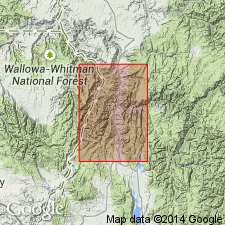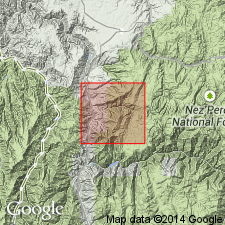
- Usage in publication:
-
- Lightning Creek Schist*
- Modifications:
-
- Named
- Dominant lithology:
-
- Schist
- AAPG geologic province:
-
- Idaho Mountains province
Summary:
Named as one of four new formations of the newly named Riggins Group. Type section is an exposure along Salmon River north of Riggins from 0.1 to 1.7 mi north of Goff Bridge, Idaho Co, ID, Idaho Mountains province. Named for Lightning Creek, T25N, Rs1 and 2E, Idaho Co. Overlies Fiddle Creek Schist (new) and underlies Squaw Creek Schist (new) [See Note Below], both of Riggins Group. Mappable southeastward to area about 4 mi east of Riggins where metamorphic grade becomes higher than at type. Upper contact with Squaw Creek questionable south of Salmon River where both formations are high-grade metamorphic rocks. Is about 8,000 ft thick on northeast limb of Riggins syncline. Composed of metavolcanic schists whose composition included mafic to silicic basalt and spilite, andesite and keratophyre, dacite, rhyodacite and quartz keratophyre. The middle- to low-grade rocks are fine-grained greenschist. Agglomerates and fine-grained tuffs were present in the original sequence. Metamorphic grade increases eastward and those rocks are gray quartz-plagioclase schist and gneiss whose dominant mafic minerals are biotite and hornblende. Many of the layers are conspicuously laminated. Was originally a sequence of massive volcanic rocks and of sediments derived directly from them. Is older than Idaho batholith. Shown as Paleozoic or Mesozoic age on geologic map.
[NOTE: In accordance with Department of Interior's Secretarial Order 3404, discontinuing use of derogatory term squaw, the Squaw Creek Schist is in process of being formally renamed either Yeva Agai Schist or Yeva Agai Naokwaide Schist (BOTH RESERVED). The geographic feature Squaw Creek, from which the geologic name was taken (this report), was renamed Yeva Agai Naokwaide by U.S. Board on Geographic Names, September 2022, USGS GNIS FeatureID 391296.]
Source: GNU records (USGS DDS-6; Denver GNULEX).

- Usage in publication:
-
- Lightning Creek Schist
- Modifications:
-
- Not used
Summary:
Some medium- and high-grade metamorphosed volcanic rocks mapped east of the Salmon River area are mapped as metamorphic units whose relative age and correlation are unknown; these rocks are tentatively correlated with the Seven Devils Group; they are shown as Permian and Triassic age; they are also mapped as present in two plates--the Rapid River and North Fork plates--of the Wallowa terrane. These metamorphosed rocks were previously assigned to formations of the Riggins Group. There is no evidence found during this study to indicate that rocks of the Riggins and the Wallowa are different island arcs. Also, all identifiable map characteristics useful for distinguishing the formations have been obliterated by multiple episodes of metamorphism and deformation. The mapped units cannot be correlated with or assigned to individual formations with confidence. Therefore, the name Riggins and its component formations are not recognized in this study.
Source: Modified from GNU records (USGS DDS-6; Denver GNULEX).
For more information, please contact Nancy Stamm, Geologic Names Committee Secretary.
Asterisk (*) indicates published by U.S. Geological Survey authors.
"No current usage" (†) implies that a name has been abandoned or has fallen into disuse. Former usage and, if known, replacement name given in parentheses ( ).
Slash (/) indicates name conflicts with nomenclatural guidelines (CSN, 1933; ACSN, 1961, 1970; NACSN, 1983, 2005, 2021). May be explained within brackets ([ ]).

